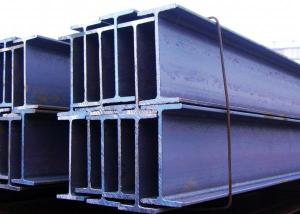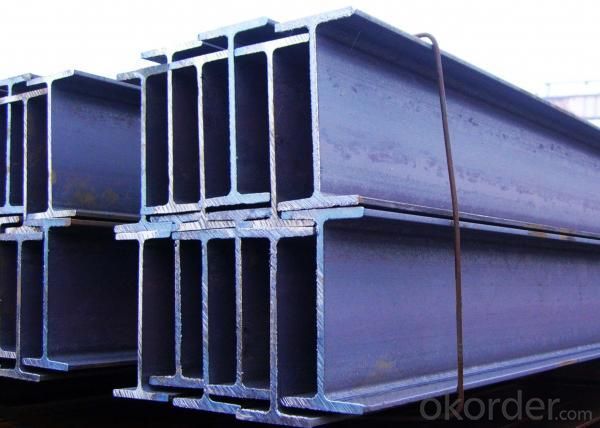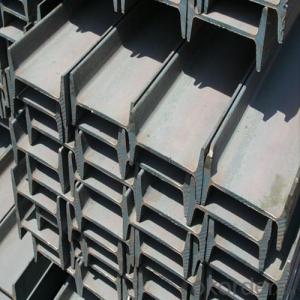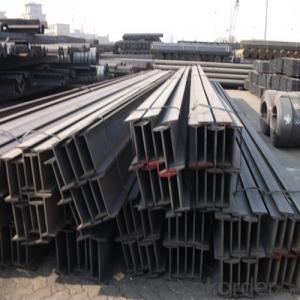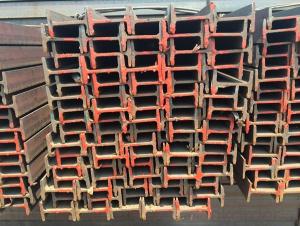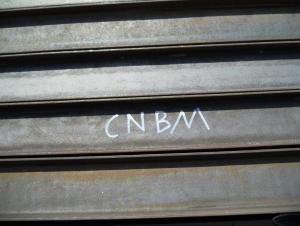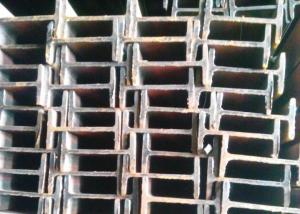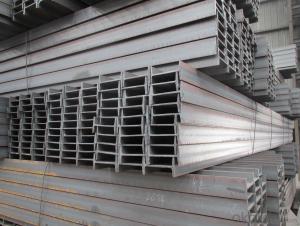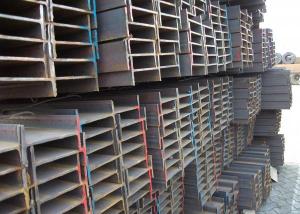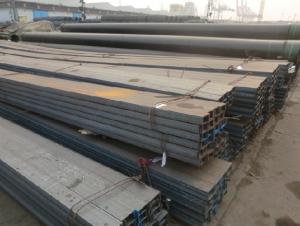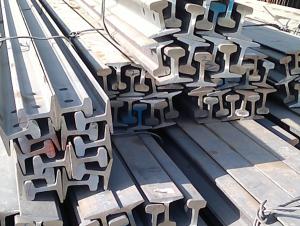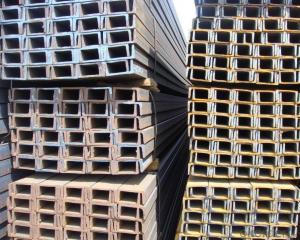I-Beam Steel
- Loading Port:
- Tianjin Port, China
- Payment Terms:
- TT or LC
- Min Order Qty:
- 25MT m.t.
- Supply Capability:
- 10000MT m.t./month
OKorder Service Pledge
OKorder Financial Service
You Might Also Like
Specifications of I-Beam Steel
Product name: I-Beam Steel
Production Standard: GB, BS, ASTM, EN, DIN, JIS
Grade: Q235B, Q345B, ASTM A36, SS400, S235JR, S275JR
Chemical composition
|
Alloy No. |
Grade |
C |
Mn |
S |
P |
Si |
|
Q235 |
B |
0.12%-0.20% |
0.3%-0.7% |
<=0.045% |
<=0.045% |
<=0.3% |
Length: 5.8M, 6M, 8M, 9M, 10M, 12M or as the requirements of the buyer
Sizes: 80MM-270MM
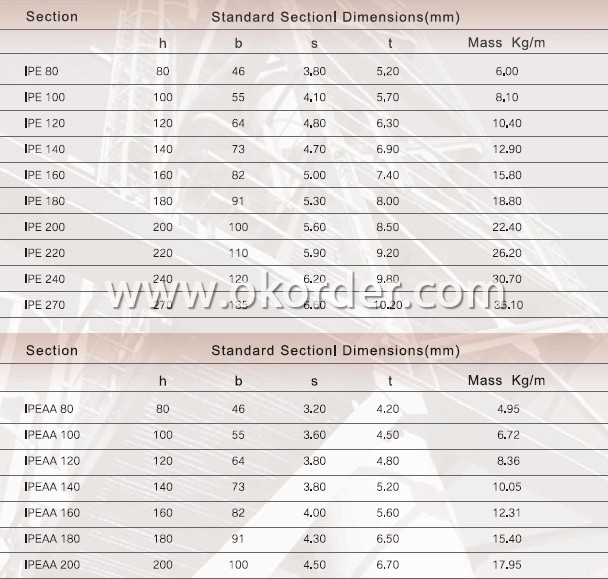
Applications of I-Beam Steel
Widely used in various building structures and engineering structures such as roof beams, bridges, transmission towers, hoisting machinery and transport machinery, ships, industrial furnaces, reaction tower, container frame and warehouse etc.
Package and Delivery
1. Package: All the products will be tired by wire rod in bundles and then put into containers 20', 40' or in bulk cargo.
Or according the requirements of the customers. Each bundle will be hung a CNBM label, which will include the information of our trademark, size, material, lengh, standard, etc. Normally, each bundle contain 50 pieces.
Bundle weight: not more than 3.5MT for bulk vessel; less than 3 MT for container load
But we can also make the bundles as the requriement of you.
2. Delivery: Within 45 days after getting the L/C ORIGINAL or the advance payment by T/T.
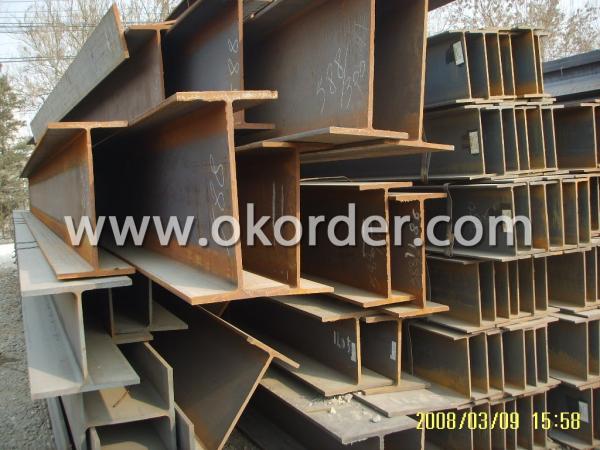
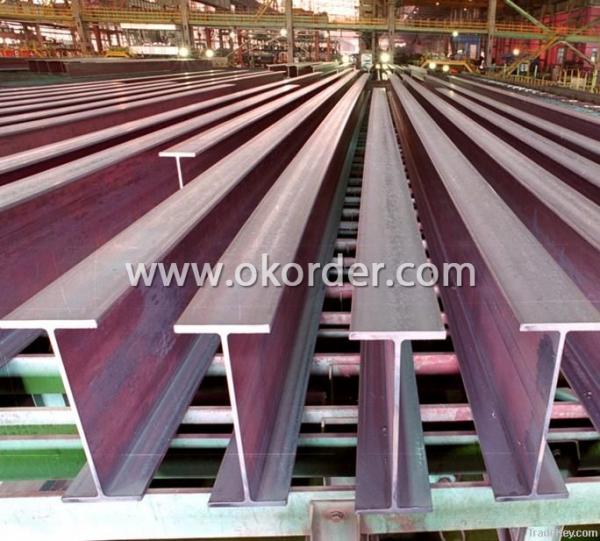
Production flow of I-Beam Steel
Material prepare (billet) —heat up—rough rolling—precision rolling—cooling—packing—storage and transportation
- Q: What are the different surface finishes available for steel I-beams?
- Steel I-beams can be finished in various ways to serve different purposes and provide distinct advantages. The most prevalent surface finishes for steel I-beams are as follows: 1. Mill Finish: This is the simplest and most common surface finish for steel I-beams. It refers to the untreated surface of the steel beam as it comes straight from the mill. Mill finish is typically characterized by a dull gray appearance and may have minor imperfections or blemishes. It is suitable for applications where neither aesthetics nor corrosion resistance are major concerns. 2. Hot-dip galvanized: To achieve this finish, the steel beam is immersed in a molten zinc bath, forming a protective coating on its surface. Hot-dip galvanizing provides excellent corrosion resistance, as the zinc coating acts as a barrier against moisture and other corrosive elements. Steel I-beams with hot-dip galvanized finishes are commonly employed in outdoor applications or environments where exposure to harsh weather or corrosive substances is expected. 3. Painted: Steel I-beams can also be coated with paint to offer protection against corrosion and enhance their appearance. The paint acts as a protective layer, and painted finishes provide a wide range of color options that can be customized to match specific aesthetic requirements. This finish is often used in architectural and decorative applications where appearance is important. 4. Powder-coated: Powder coating is a dry finishing process in which a powdered coating material is electrostatically applied to the steel beam and then cured under heat. This process results in a durable, smooth, and uniform finish that offers excellent corrosion resistance. Powder-coated steel I-beams are frequently utilized in both indoor and outdoor applications that demand both durability and aesthetics. This finish can also be customized in terms of color and texture. 5. Black oxide: Black oxide is a chemical conversion coating that forms a thin, black oxide layer on the surface of the steel beam. This finish provides mild corrosion resistance while enhancing the beam's appearance with a dark, black color. Black oxide finishes are commonly used in applications where a sleek and uniform appearance is desired, such as architectural or decorative elements. In conclusion, steel I-beams can be finished with mill finish, hot-dip galvanized, painted, powder-coated, or black oxide surfaces. Each finish offers unique advantages in terms of corrosion resistance, aesthetics, and suitability for specific applications. The choice of surface finish depends on factors such as the intended use, environmental conditions, and desired appearance.
- Q: What is the average weight of a steel I-beam?
- The weight of a steel I-beam can differ based on its size and dimensions. Nevertheless, as a general rule, the weight of a steel I-beam usually falls within the range of approximately 33 pounds per foot (lb/ft) to 200 lb/ft or higher. Several factors, including the beam's length, width, and height, along with the type and grade of steel utilized in its construction, influence its weight. To obtain precise weight information for a specific I-beam, it is vital to refer to engineering and construction specifications.
- Q: What is the difference between steel tubes such as channel steel and square tube?
- The use of square construction, machinery manufacturing, shipbuilding, steel construction projects, solar power support, steel structure engineering, power engineering, power plant, agricultural and chemical machinery, glass curtain wall, car chassis, airport, boiler construction, highway railings, housing construction, pressure vessels, oil tanks, bridges, power station equipment. Cranes and other high load welding etc..
- Q: What are the considerations for constructability and ease of installation with steel I-beams?
- Some considerations for constructability and ease of installation with steel I-beams include the weight and size of the beams, the availability of equipment and machinery to lift and position them, the need for proper alignment and connections, and the potential for on-site modifications or adjustments. Additionally, factors such as site access, temporary support requirements, and coordination with other trades or construction activities also need to be taken into account.
- Q: Are there any limitations to the depth of steel I-beams?
- The depth of steel I-beams is subject to certain limitations. Various factors, including structural load requirements, span length, and design considerations, determine the depth of an I-beam. As the depth increases, the I-beam's ability to resist bending and deflection also increases. Nevertheless, practical limitations exist due to manufacturing constraints, transportation limitations, and construction considerations. Manufacturing constraints can restrict the maximum depth of I-beams that can be manufactured. The production of large or extremely deep I-beams may require specialized equipment or techniques that are not readily available or cost-effective. Transportation limitations also come into play, as longer or deeper beams may prove challenging to transport to construction sites, particularly in urban areas or areas with limited access. Furthermore, construction considerations, such as building height, space constraints, and architectural requirements, may impose limitations on the depth of I-beams. In high-rise buildings, for instance, the available floor-to-floor heights may impose restrictions on the maximum depth of I-beams that can be utilized. Architects also take into account the aesthetics and visual impact of the structural elements, and excessively deep I-beams may not align with the desired design intent. In conclusion, the depth of steel I-beams is subject to limitations influenced by manufacturing constraints, transportation limitations, and construction considerations. When selecting the depth of I-beams for a given application, designers and engineers must carefully consider these limitations and find a balance between structural requirements and practical constraints.
- Q: How do you install steel I-beams correctly?
- Installing steel I-beams correctly requires careful planning and proper execution to ensure structural integrity and safety. Here is a step-by-step guide on how to install steel I-beams correctly: 1. Determine the suitable beam size and length: Calculate the load-bearing requirements and span distance to select the appropriate steel I-beam size and length. Consult with a structural engineer or a professional to ensure accuracy. 2. Prepare the site: Clear the area where the I-beams will be installed, removing any debris or obstructions. Ensure the foundation or supporting structure is in place and meets the necessary specifications. 3. Prepare the I-beams: Clean the steel I-beams thoroughly to remove any dirt, rust, or debris that could affect their stability. Inspect the beams for any defects or damage and address them accordingly. 4. Position the I-beams: Carefully lift the I-beams into position using appropriate lifting equipment, such as a crane or forklift. Ensure the beams are properly aligned with the foundation or supporting structure. 5. Secure the I-beams: Use suitable connectors or brackets to fasten the I-beams securely to the foundation or supporting structure. It is crucial to follow the manufacturer's specifications and use the correct type and size of connectors. 6. Check alignment and level: Verify that the installed I-beams are level and properly aligned. Use a spirit level or laser level to ensure accuracy. Adjust if necessary. 7. Weld or bolt connections: Depending on the design and specifications, secure the connections between the I-beams and other structural components by either welding or bolting. Follow relevant safety procedures and adhere to welding or bolting codes and standards. 8. Inspect and reinforce: Conduct a thorough inspection of the installed I-beams, paying attention to welds, connections, and any potential stress points. Reinforce weak areas or make necessary adjustments as per the engineer's recommendations. 9. Obtain necessary approvals: Before proceeding with further construction or load-bearing activities, ensure that the installation meets all local building codes and regulations. Obtain any required permits or inspections. 10. Seek professional assistance: If you are not experienced or confident in installing steel I-beams, it is essential to consult with a professional or structural engineer to oversee the process and provide guidance. They can ensure the correct installation and compliance with all relevant standards and regulations. Remember, proper installation of steel I-beams is crucial to the structural integrity of a building or structure. It is always recommended to seek professional advice and assistance to ensure a safe and accurate installation.
- Q: How are steel I-beams transported and installed?
- Steel I-beams are typically transported and installed using heavy machinery and specialized equipment due to their size and weight. The transportation process involves loading the I-beams onto a flatbed truck or a trailer specifically designed for carrying large and heavy loads. These trucks are equipped with cranes or other lifting mechanisms to safely load and unload the I-beams at the construction site. Upon arrival at the site, the I-beams are carefully unloaded and positioned using cranes and hoists. The installation process requires a team of skilled workers who work together to lift, position, and secure the I-beams in place. The beams are often connected to other structural elements, such as columns or girders, using bolts or welding techniques to ensure stability and structural integrity. Before installation, precise measurements and calculations are made to determine the appropriate size and placement of the I-beams. This ensures that the beams can withstand the loads and stresses they will be subjected to during their intended use. Proper alignment and leveling are crucial during installation to ensure the overall structural stability of the building or structure. Safety precautions are paramount throughout the entire transportation and installation process. Workers involved in handling and positioning the I-beams are required to wear protective gear, such as hard hats and safety harnesses. Additionally, rigorous safety protocols are followed to prevent accidents and ensure the well-being of all workers on site. In summary, the transportation and installation of steel I-beams involves the use of heavy machinery, skilled workers, and careful planning. These beams play a crucial role in supporting the weight and loads of buildings and structures, and their proper installation is essential for ensuring structural integrity and safety.
- Q: What are the common finishes or coatings applied to steel I-beams?
- Steel I-beams can be enhanced in durability, aesthetic appeal, and corrosion resistance through the application of various finishes or coatings. Some commonly used options include: 1. Hot-dip galvanizing, which involves immersing the steel I-beams in molten zinc to create a protective layer that prevents rust and corrosion. This method is ideal for outdoor or high-moisture environments. 2. Powder coating, where a dry powder is applied to the steel I-beams and then cured under heat to form a durable finish. This process allows for a wide range of colors and textures, providing both protection against corrosion and aesthetic appeal. 3. Epoxy paint, which offers excellent adhesion and resistance to chemicals, making it suitable for harsh environments. Typically applied in multiple coats, epoxy paints create a tough barrier against corrosion. 4. Metallic coatings, such as aluminum or zinc, can be applied to steel I-beams using methods like electroplating or thermal spraying. These coatings provide a sacrificial layer that corrodes before the steel, thus extending the lifespan of the I-beams. 5. Primer/topcoat systems provide additional protection by coating the steel I-beams with a primer to enhance adhesion, followed by a topcoat for aesthetic appeal and resistance to corrosion. This type of system is commonly used in architectural or decorative applications. It is important to consider the intended use and environmental conditions when choosing a finish or coating for steel I-beams. Seeking advice from professionals or manufacturers can assist in determining the most suitable option for specific requirements.
- Q: How do steel I-beams perform in terms of impact resistance?
- Steel I-beams are known for their exceptional impact resistance. Due to their shape and composition, they can withstand high levels of force and distribute the impact energy efficiently, making them highly resistant to deformation or failure. This makes steel I-beams a reliable choice for applications that require structural stability and protection against impact, such as in construction, bridges, and heavy machinery.
- Q: Are steel I-beams fire-resistant?
- Steel I-beams are not inherently fire-resistant. However, they have a high melting point which allows them to withstand fire for a longer duration compared to other building materials like wood. To enhance their fire resistance, steel I-beams are often coated with fire-resistant materials or encased in fire-rated materials such as concrete or gypsum to provide additional protection against fire.
1. Manufacturer Overview
| Location | Qinhuangdao, China |
| Year Established | 2000 |
| Annual Output Value | Above US$ 300 Million |
| Main Markets | Mid East; Africa; Southeast Asia; Brazil |
| Company Certifications | ISO 9001:2008; |
2. Manufacturer Certificates
| a) Certification Name | |
| Range | |
| Reference | |
| Validity Period |
3. Manufacturer Capability
| a) Trade Capacity | |
| Nearest Port | Tianjin; |
| Export Percentage | 70% - 80% |
| No.of Employees in Trade Department | 21-50 People |
| Language Spoken: | English; Chinese; |
| b) Factory Information | |
| Factory Size: | Above 400,000 square meters |
| No. of Production Lines | 2 |
| Contract Manufacturing | OEM Service Offered; |
| Product Price Range | Average |
Send your message to us
I-Beam Steel
- Loading Port:
- Tianjin Port, China
- Payment Terms:
- TT or LC
- Min Order Qty:
- 25MT m.t.
- Supply Capability:
- 10000MT m.t./month
OKorder Service Pledge
OKorder Financial Service
Similar products
Hot products
Hot Searches
Related keywords
